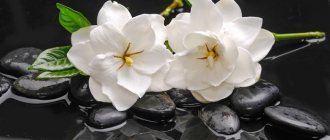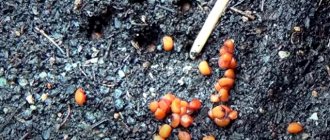Various plants are used to decorate houses and greenhouses; blooming jasmine will be very pleasant to observe on any windowsill or in a closed summerhouse.
The aroma of flowers will spread throughout the entire area, and create comfort in the room or space next to the pot. Since the plant variety is not particularly hardy, it requires constant careful care; you should definitely pay attention to this.
Brief overview of the article
- climbing vine
- general description
- Filling with flowers
- Volumetric buds
- Plant care
- Primary requirements
- Special attention
- Room temperature
- Fluid requirement
- Autumn and winter
- Photo of jasmine
A little history about jasmine
Many ignorant people confuse mock orange, which grows everywhere in central Eurasia, with real jasmine. That is why, when talking about jasmine, they always clarify what kind they are talking about, real or false.
The exact place of origin of this representative of the flora has not yet been fully revealed. While the olive branch, which is a prominent representative of the family, is mentioned in ancient scrolls and depicted on vases and amphorae found on the island of Crete dating back to the 2nd millennium BC, there is no such evidence for jasmine. But China is conventionally considered to be the birthplace of jasmine. But such a statement remains controversial. Since jasmine is still the national flower of Pakistan, India and the Philippines.
Translated from Persian, the word “yasmin” is translated as a fragrant flower. Indeed, the scent of jasmine cannot be confused with another scent.
The enchanting aroma of this plant has been known throughout the world since ancient times. There are references to the use of this plant for decoration and flavoring in the palaces of different countries of distant times. To this day, wreaths and garlands are woven from jasmine flowers for honored guests, for weddings in different Asian countries, in Indonesia on the Pacific Islands.
In Latin American countries, India and Italy, the shoots and flowers of the plant are important religious attributes. Until now, jasmine oil, which is used in perfumery and pharmaceuticals, is the most expensive essential oil in the world (there are about 7 million flowers per 1 kilogram, the cost is almost $6,000).
Features of the plant
There are more than 200 species and varieties of jasmine in the world. All of them are evergreen shrubs with climbing stems that sometimes reach a height of more than 10 meters. Of all the types of jasmine, about 90 are ornamental houseplants.
All types of climbing jasmine vary in color of flowers and leaves.
Leaf shapes can be different:
- Simple.
- Opposite.
- Pairi-pinnate.
- The next one.
Triple.
Their shades and colors are varied, combining the entire palette of green. Jasmine flowers are tubular, collected in star-shaped inflorescences. There are simple and terry ones. May consist of 5 or more petals. There are 2 thousand stamens inside the flower tube. The most common flowers are white. But a number of varieties have a lemon and yellow color. Several species of this plant have soft pink flowers.
Breeders have created varieties with golden and pearly white flower petals.
The flowers are collected in umbellate inflorescences of several pieces. The calyx of the flowers is funnel-shaped or bell-shaped, sometimes cylindrical. The ovary of the flowers becomes a black berry when ripe.
The development and growth of this plant occurs very quickly. Flowering is long-lasting, especially in natural conditions. Flowering usually occurs from April to November. But some varieties bloom in winter.
Room temperature
Jasmine is not so demanding regarding this indicator, but it is still worth paying attention; the optimal differences on the thermometer are considered to be 21-25 degrees. During the cold season, numbers that drop below 16 degrees in the room will be critical; this can lead to irreversible consequences.
During the winter, different varieties of this flower are kept under special conditions, so preparation of the place for the plants begins in advance. To achieve the most effective flowering, all nuances must be strictly observed, otherwise this process will be short and sparse.
Varieties and types of jasmine
Of the variety of jasmine varieties, the most popular among gardeners are:
- Large-flowered jasmine (medicinal). The most unpretentious of all jasmines. Grows in almost any home environment. It can reach a height of 10 meters if not trimmed in a timely manner. It has large white star-shaped flowers. The leaves are small. In the south of the country, in the Caucasus, it is grown in open ground for industrial use.
- Jasmine multiflora. This is a real vine that wraps around any support. It blooms with small white flowers that look like stars. Requires regular pruning of shoots to avoid bare branches.
- Holofloral jasmine. A shrubby type of plant with penetrating shoots. In winter, after the leaves fall, the flowering period begins; the flowers are bright yellow, located in the axils of the leaves.
- Jasmine sambac (Arabic or Indian). Has long shoots. A very flexible plant. To give this variety of jasmine the appearance of a shrub, you have to frequently prune it. The flowers are white, double, very fragrant. When they bloom, they take on a pink color. In southern countries it is grown for industrial use. The flowers of this particular variety of jasmine are used to make the famous Chinese green teas with jasmine. Cultivated since 1665.
There are varieties of sambac:
- Grand Duke with rose-like flowers and a rich and sweet aroma,
- A beauty of India, with miniature white flowers, blooming all year round,
- Arabian Knights is a fast-growing, unpretentious shrub jasmine with small fragrant double flowers,
- Maid of Orleans is the easiest variety to grow, blooming with small, non-double flowers all year round, with a strong aroma,
- The Grand Duke of Tuscany has the largest flowers of all sambacs, develops slowly, is picky about growing conditions, and the flowers dry out on the plant without falling off,
- Mali Chat has several tiers of growth, develops slowly, blooms with double white “roses”, and is difficult to grow.
- Royal jasmine. It has large oval leaves and large white flowers (diameter up to 7 centimeters). Blooms in winter. Surprisingly, it has no smell.
- Jasmine Bisa. Grows naturally in the mountains, not picky. Support is needed. To grow indoors, pruning of shoots is required. The flowers are bright pink, fragrant. It blooms only in May-June.
- Low jasmine. It has bare shoots and is not tall. The flowers are collected in inflorescences, small, yellow in color with a long tube. Flowering period is summer.
- Jasmine turned away. A shrub plant with paired leaves. The flowers are light yellow, small, fragrant, with turned-up petals. Blooms all summer.
- Jasmine flattened. A shrub variety with purple flowers. Has a delicate aroma. Blooms for a long time. Requires rare pruning.
- Primrose jasmine. A creeping plant that requires support. It blooms with small, yellow, odorless flowers. Flowering occurs from spring to autumn.
- Madagascar jasmine (Stephanotis). A popular indoor plant with large flowers and a strong pungent odor. Blooms all year round. May cause allergies.
- Star jasmine differs from other types of plants in its weak aroma, large spotted leaves, and large simple flowers.
- Jasmine Lerata. A special variety of jasmine with a subtle mint aroma and lanceolate waxy flowers.
This is only a part of the varieties and types of jasmine that have won recognition among indoor plant lovers.
Growing conditions for climbing jasmine
The plant is quite unpretentious, but prefers bright, unshaded places. Window sills on the east side of the house are the best option for placing flowerpots with these flowers. Does not like direct sunlight.
Jasmine prefers high air humidity, so in the hot season and during drought the plant should be sprayed. In this case, the air temperature should be no higher than +30 degrees and lower than +10 degrees.
Jasmine requires watering regularly, but does not tolerate overwatering.
Calcareous soil is harmful to the plant. It is recommended to acidify the soil periodically. When grown indoors, periodic feeding should be done. To do this, apply either organic or mineral fertilizers to the soil at least once a month, except in the winter.
- Experts recommend replanting plants annually in the spring for young plants, and for jasmine older than 3 years - once every 3-4 years.
- The soil needs to be loose, acidified, with the addition of peat.
- You can use ready-made commercial soil for azaleas. It is necessary to have drainage in the soil in the form of expanded clay.
Since jasmine is a climbing plant, the formation of a bush requires pruning and pinching of shoots. The time for circumcision is spring. Almost all types of jasmine need support.
There are 2 ways to propagate jasmine at home: cuttings and air layering.
The plant takes root easily in any case. The germination period during reproduction is up to one and a half months.
Fluid requirement
At each stage of growth, jasmine will require different amounts of water, these points will be very important for maximum effect. The most intense and abundant procedures occur in spring and summer; at this time of year, owners are very vigilant and scrupulous in irrigating leaves and soil.
You should start watering the soil only when a drying crust begins to appear on it; this indicator has never failed. In this case, the soil will not be too wet and things will not dry out too much. A stable environment can only be achieved through constant monitoring of the humidity level.
Its features and uniqueness
The more you know about jasmine, the easier it will be for you to understand the nature of this shrub and the easier it will be to care for it . The homeland of the jasmine flower lies in the distant Mediterranean. Many centuries ago, a cult of the flower was formed in those parts. He was in every house, in every garden, in the hair of girls and in the suits of men.
Over time, they began to make oils from jasmine, infuse perfumes, and brew them into tea. At the beginning of the 14th century, the medicinal properties of the flower were discovered as a sedative and anti-inflammatory agent. And this is such a wonderful plant you can grow in your dacha!
Despite the abundance of different properties of jasmine, you, like many other gardeners, will most likely grow it exclusively as an ornamental plant. The beautiful lush white crown will enchant you, and you will forget that many peoples have been brewing jasmine petals into tea for centuries for better sleep.
Garden jasmine is incredibly beautiful during its flowering period, when white and yellow inflorescences bloom, representing a single growing harmony . The flowers also emit an incredibly delicate, enveloping scent especially strongly during the flowering period.
Jasmine during active flowering
Today, there are several dozen different types of jasmine, which differ mainly in the size of the flower and the shape of its petals. But all these species have one thing in common: complete adaptation to different climatic and weather conditions.
There is no need to rack your brains over the planting location, since the shrub can germinate equally quickly in the shade and in the sun. Jasmine is also unpretentious in choosing the sides of the horizon, be it north or south. If you take care of the shrub, it will easily withstand both many days of drought and abundant humidity without consequences.
Bloom
The budding period of this beauty begins at the end of May , beginning of June. The first flowering lasts about a month and a half. There are many inflorescences, all open fully. In sunlight, the color fades a little and fades. Throughout the entire growing season, new shoots grow and buds immediately appear on them. At the end of August, closer to autumn, the time for the second flowering comes. It's not as lush as the first one. Individual brushes open. Lasts about two weeks.
Care before and after
Caring for a climbing rose before flowering involves systematically loosening the soil, removing weeds, fertilizing, and pruning. In the spring, they are fed with nitrogen fertilizers to enhance growth, and closer to the time of budding, potassium fertilizers are used.
After flowering, the climbing rose must be properly pruned. Remove dry inflorescences, dead, damaged vines, if there is a need to thin out an overgrown bush. Afterwards, feed the plant with potassium-phosphorus mineral fertilizer.
After autumn flowering, one or two flowers are left on each vine so that the fruits begin to form . Thus, the shoots will survive the winter better, gain strength, and bloom profusely next year.
What to do if it doesn't bloom?
There are many reasons for the lack of flowering, for example as a result of:
- improper pruning;
- poor soil quality;
- excess nitrogen fertilizers;
- unsuitable landing site;
- bad wintering.
To restore flowering, you need to determine the cause and take appropriate measures.
Main types
Below we describe the most popular types of fluffy plants.
Small-leaved jasmine
Small-leaved jasmine is one of the shortest plants, the height of which rarely exceeds 100 cm. The main distinguishing feature of the species is the strongly curved leaf plate. This arrangement of the flower protects the pistils from pests.
Small-leaved jasmine also stands out among other species for its aroma, which is similar to the smell of strawberries and cream.
Ordinary
Common crown jasmine is one of the most common plant species in central Russia. Frosts do not damage its root structure, and cold autumn does not damage its delicate flowers.
The growth of the plant during its peak period can reach 300 cm in length. And the thickened leaf plates have an unusual golden color.
Fluffy
Downy jasmine is undoubtedly one of the most beautiful species of Mediterranean shrub. Its length can reach 450 cm upward, although the width for a person will be simply immense. Therefore, the fluffy type of jasmine is recommended to be planted in large gardens and parks. This species needs space.
In addition, it emits almost no odor, which makes it an ideal shrub for parks where many children with possible allergies to such flowering walk.
Fluffy jasmine blooms for a whole month.
Filling with flowers
Jasmine is perfect for home use when planted in a small pot, and the appearance of a multi-flowered specimen will effectively hide the container when the buds open.
The distinctive features of this plant can be safely called strong branching and a possible height of an adult stem of up to 2 meters. The leaves of this variety will have wavy edges and a dark green surface color, which will strikingly distinguish it from other nearby growing individuals. The highlight will be the blooming flowers, of which there are a lot, and the aroma they emit is impossible not to feel.
Features of choosing a landing site
So, we have already said that jasmine is an absolutely unpretentious plant. However, when choosing a landing site, we still recommend that you consider our following recommendations.
First of all, you must decide in what form you want to see jasmine bushes in your garden: it will be a separate bush, a hedge, or maybe several different plantings dispersed throughout the garden.
Based on this knowledge, pay attention to the following tips:
Features of shrub care
One look at the blooming jasmine petals will tell you whether this plant is being cared for or not. Shrub care involves systematic watering and fertilizing (feeding).
Fertilizer
Please note that it is best to feed the plant in early spring, that is, during the period of intensive growth of your jasmine. This is when the shrub is most receptive to the nutrients you fertilize it with.
It is necessary to feed jasmine strictly with mineral fertilizers, otherwise you will ruin the flower.
For one medium-sized jasmine bush you will need mineral liquid with fertilizer in the following proportions:
- 5 liters of fresh cold water
- 13-16 g superphosphate
- 6-8 g urea
- 6-8 g potassium sulphide
We should also not forget about manure, which was, is and will remain the best fertilizing substance. In this case, it is necessary to dilute the manure with clean cold water in a ratio of 1:10. Before you use the resulting liquid, let it steep for several days.
Few people know that jasmine can be fertilized with ash from an old fire. This remedy is undoubtedly very effective, however, it is very important to watch the consistency of the ashes that you scatter over the bush. It should be thin and sparse, otherwise you will ruin the petals.
Watering
Despite the resistance of the Mediterranean shrub to various weather changes, it reacts very painfully to cold water.
In extreme heat, after the sun has gone down, you can spray the entire plant.
So, you need to water the jasmine with lukewarm, soft water . To do this, you need to pour regular well water into a watering can or any other reservoir and let it sit for at least a day.
You need to water the bush carefully and carefully. Make sure that strong jets of water do not fall directly on the flowers, because the petals may not withstand the strong pressure. Irrigate the plant at its roots.
Also note that in extreme heat it is necessary to spray the plant itself. This will allow you to cool the flowers, saturate them with liquid, and remove dust from the leaves, increasing the rate of photosynthesis.
Weeds need to be removed regularly
Here are some more tips for caring for jasmine that will help you prolong the life of the shrub and make it the main decoration of your garden:
Trimming
Systematic watering and regular care is only one step towards creating a truly lush and fragrant jasmine leaf . Another very important point is pruning your planting. Moreover, this must be done regularly and competently.
Pruning jasmine in spring
Here are 4 rules for properly pruning garden jasmine:
- Carry out the first pruning no earlier than three days after planting
- trim all branches of the bush that look to the side, not up
- carry out cutting work before the first buds appear
Step-by-step instructions: how to propagate?
Rose Jasmine (Jasmina) reproduces vegetatively. This is the only way to achieve preservation of all varietal qualities.
- After the first flowering in the summer, cuttings are prepared.
- You need a young, thick shoot with 2 internodes.
- Using a sharp knife, make the lower cut at 45°, and the upper one straight above the kidney.
- Deepen the cuttings 1 cm in wet sand, cover the top with a jar or polyethylene.
- Leave it like this until the roots appear.
For true connoisseurs of climbing roses, we have prepared many articles on the pages of our website about the different varieties of these beauties. Read about these: Gloria Day climbing, New Down, Super Dorothy, Golden Gate, Don Juan, Iceberg, Lavinia, Rosarium Utersen and Laguna.
Preparing the bush for winter
Winter is the hardest time for delicate jasmine . In order to protect your shrub from the cold and prevent it from dying irrevocably, you will need to carry out a number of special works every year. They won't take up much of your time.
Sheltering the plant for the winter
Here's what you need to know about preparing jasmine for winter:
If you are planning to “relocate” a shrub to a new location, then it is best to do this at the end of spring.
Reproduction methods
The snow-white, fluffy shrub can be propagated in three basic ways : layering, cuttings, and dividing the root system.
The last method is the most difficult, and the easiest way to propagate jasmine is using cuttings. Let's look at each in more detail.
Using cuttings
Cuttings should be prepared for propagation at the beginning of summer using a thin, sharp knife. A cutting ready for planting is a stalk no more than 6 cm high and has at least a pair of leaves on the sides.
Reproduction by layering
Two options for propagation by layering
Jasmine should be propagated using layering strictly in mid-spring.
Proceed as follows:
Dividing the root system
Propagating jasmine by division is quite labor-intensive work, so you should resort to this method only if your plant has grown around the perimeter and was intended as a hedge.
To propagate by dividing the root system, you need to dig up a bush and divide it into several equal parts , each of which has its own root system. Immediately after dividing, plant each of the divided parts of the shrub.
Conclusion
Jasmine in landscape design
Most varieties of garden jasmine are unpretentious to weather conditions, however, they will thank you for constant watering, care and feeding. Use our tips for planting and caring for jasmine, and the snow-white shrub will delight you with its fluffy crowns and unique aroma for many years.
How to propagate mock orange or garden jasmine
Garden jasmine: description, types, planting in open ground, care, pruning, propagation (60+ Photos & Videos) + Reviews
Feedback from our readers is very important to us. Leave your rating in the comments with reasons for your choice. Your opinion will be useful to other users.
Jasmine (Jasminum) belongs to the Olive family.
Homeland - tropical and subtropical regions of India, Africa and America. Jasmine is an evergreen or deciduous climbing shrub or liana. The smooth stem is covered with trifoliate, odd-pinnate leaves of a dark green color, 2.5-5 cm long. Large flowers of regular shape bloom at the ends of the branches. The average bush reaches 4.5 meters.
The jasmine flower has the following description: in the center there is a long corolla, similar to a narrow tube, inside which there are two thin threads that grow together and form a berry. This is the fruit of a plant that cannot be used as food.
general description
As for the green mass, jasmine, which requires attention to care for, is distinguished by its perfectly oval leaf shape, with beautifully pointed tips. The pairwise arrangement looks good, and the graceful little leg perfectly complements each leaf.
If you look closely, the graceful plant resembles a magnificent green crown. In addition to their aroma, the flowers have some characteristics; their appearance can be either double or tubular.
Each unit opens very well and throws out beautiful corollas; a voluminous bud of 6 petals literally covers the cylindrical tube from view.











